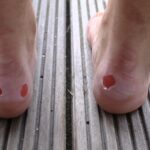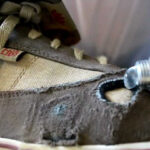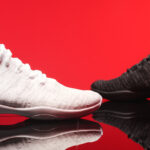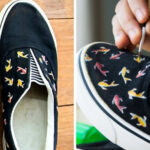Have you ever felt your shoe rubbing against your heel and thought that it was just an uncomfortable feeling? Well, this is because the shoe may not be fitting properly. If shoes rub on your heel, there are a few different things that could be happening. In this blog post, I will tell you how to break in shoes that rub your heels so you can finally enjoy wearing them again!First of all, if you have narrow feet then they might be too wide for your foot so they rub against the back of your heels when walking. Secondly, if you have wider feet than normal then it’s possible that the shoe might still fit but isn’t structured well enough to support both sides of the foot which will cause one side to slip forward so it can press into the other side’s arch or heel area causing friction as well as discomfort.

Shoes that rub your heel can be an annoying problem to deal with. You may have tried everything from heel cushions, insoles, and bandages to solve the issue of shoes rubbing your heels raw. While these fixes are helpful in getting you through a tough time, they often don’t last long or work for everyone.
17 Tips on How to Break in Shoes That Rub Your Heel
1. Putting Heel Inserts
Put some heel inserts into the shoes. These will help soften the rubbing against your skin and make it more comfortable to wear them for a short period of time. They can be removed if your heels start getting rubbed raw again too soon or they don’t work out in the long run as well
2. Adding an Extra Layer

Add an extra layer over any sensitive areas on your feet that are being irritated by friction from where you’re wearing tight socks, stockings or tights with seams going across them – this is typically around the toes, ankles or back of your foot under the arch at the ball joint area. You could use a small bandage wrapped tightly around these parts but I prefer using cloth tape because it sticks better than anything else I’ve ever tried
3. If the Shoes Are Too Tight in General
Try loosening them as much as you can and see if that solves any of your problems – this is especially true for running shoes or other athletic footwear where there’s a lot of compressive force on the heel from walking, jogging or jumping around. You might need to take these off every now and then just so they don’t rub against your skin too much but it will help make sure that you’re wearing them at least a few hours each day without getting blisters all over your feet too quickly.
4. Understanding Your Correct Shoe Size
Most people are wearing incorrect shoe sizes, which is one of the most common causes of heel rubbing. If you know your correct size but still have problems with shoes rubbing against your heels, then it’s time to change either the shape or type of shoe that feels best on your feet
5. Putting a Thick Sock on Your Heels
Some people might try putting socks on their heels to help get the rubbing sensation down. It’s not a bad idea but it does take some time and patience. Try putting a thick sock and check if the problem still exists. Wear thicker socks to cushion your feet from rubbing against the back of your shoe’s heel area.
6. Get New Insoles
An insole is a thin insert that goes inside your shoe to make it feel more comfortable. They are often made of materials like foam, gel or cork. If you have a thinner shoe then put in an insert for added cushioning.

Get new insoles, which can be found at most drugstores or online stores like Amazon. But you need to look for the best insoles that will fit your feet.
7. Walk in Your Shoes for Longer Periods of Time
The more you wear the shoes, they’ll give up on rubbing against your heel and this usually takes a couple of weeks or so. But if it’s not working, then try another shoe that feels better to walk in. This could.
8. Put a Band-Aid on the Heel
Put a band-aid or adhesive bandage on your heel to help reduce pain and discomfort. The pressure of the adhesive will help create an area that’s not as tight, which can decrease rubbing in other areas. If you are looking for more substantial protection then try putting some padding around the heel.
9. Buy Some Gel Heel Liners
Gel heel liners will help you feel better and walk more comfortably. Oftentimes, heel liners are made of a gel that conforms to the shape of your feet and helps with relieving pressure points around the heels.
10. Buy Some Pads for Your Heels
When all else fails, you can buy some pads that will help relieve rubbing in other areas as well (for example on the tops of your toes). Try these before considering special insoles which may not work if they’re too narrow for your foot width. It is possible to find generic versions online but this option might be cheaper than what’s available at major retailers.
11. Put a Thin Layer of Petroleum Jelly On The Inside of Your Shoes
If you have a pair of flats or loafers, this is a cheaper and less drastic solution. Rub some petroleum jelly on the inside soles where they touch your feet to prevent blisters from forming. The gel in the heel liners can also be applied for this purpose too.
BONUS TIP: Don’t Wear Pointy Toe Shoes!
Pointed-toe shoes make it more difficult to walk than round-toe shoes because they cause greater pressure on different parts of our foot as we walk (making them unsafe for walking long distances). For work purposes, heels are usually necessary but if possible try wearing closed toes instead such as oxfords, brogues or pumps so that your toes are protected
12. Use Moleskin to Cover Your Heel
Use moleskin or other soft material to cover your heel and cut it into strips so you can wear it like a bandaid over the area where you’re experiencing pain when wearing shoes with heels.Moleskin is a synthetic fabric that can be cut into shapes or strips and will adhere to your skin so it doesn’t slide around. It also has adhesive on one side which makes it stick to itself, making it easy for you to cover your heel if you need extra padding in some areas of the shoe where rubbing occurs.
The adhesive property of moleskin allows us to use this material over any area we experience pain when wearing shoes with heels; whether its our toes, balls of feet, arch or instep-moleskin can even be used as an alternative solution instead of gel insoles and other forms of cushions inside the shoe
13. Apply a Thick Coat of Foot Powder
Apply a thick coat of foot powder before putting on your shoes. This will help stop moisture from being trapped inside of your shoes.
14. Change the Way
Change the way you walk in order to avoid strain on your heel. Walk with a backswing or side-to-side motion instead of forwarding momentum for more support when walking.
15. Try Wearing Footwear
When possible, try wearing footwear that is wider at the toe area than they are at the heel. This will lessen any friction between shoe and foot by distributing it evenly over all surfaces
16. Consult a Podiatrist
If pain persists despite these tips, consult a podiatrist who can help determine what is likely causing it (e.g., plantar fasciitis) so appropriate treatment can be prescribed as well as specific shoes recommended
17. Wear the Right Shoe for Your Feet Type
Choose a shoe that offers adequate arch support and is not too narrow, as these types of footwear are more likely to cause blisters and other foot problems after prolonged wear. If you have high arches or a flat foot, look for shoes that are fitted with an insole or arch supportLightweight footwear may also help to minimize pain from other sources like heel spurs and plantar fasciitis. For these conditions, it is best to consult a podiatrist who can recommend appropriate treatment as well as specific types of shoe you should wear.
18. Addressing Any Other Foot Issues
If all else fails and no amount of breaking in can stop those nasty blisters from forming under a new pair of shoes. Make an appointment with a podiatrist who specializes in foot care so they can take a look at what might be causing this issue. Don’t let pain get in the way – especially when there are other solutions out there!
Frequently Asked Questions
Why Do Shoes Rub Blisters on Heels?
Heels are notorious for rubbing blisters on the heels. This is because they have a tendency to cause friction between the heel and foot, which can cause an accumulation of fluid in the space between your toes.
There are many causes of this issue, but it mostly occurs when you wear too tight or uncomfortable shoes. The result is a blister that becomes painful and inflamed when the shoe rubs against it.
However, there are also some other reasons why your heels might be rubbing blisters on their heels:
- Shoes that do not fit properly may cause abrasions on your heel due to inadequate padding.
- There could be a buildup of skin cells from walking barefoot over time.
What to Put on Heels to Prevent Blisters?
- Make sure that your heels are clean and dry before wearing them.
- Put a thin layer of petroleum jelly on the heel of your foot and rub it in to make sure it is completely covered.
- Wear socks with a cotton top that won’t get in the way of your feet or toes.
Why Do Shoes Always Give Me Blisters?
The most common reason for getting blisters is not wearing the correct shoes. Shoes that are too tight or shoes with hard surfaces can cause your feet to rub against them and lead to blisters.
If you find blisters in one place more than others, it may be because of a different foot structure or a certain way your shoe fits. If you want to avoid getting these painful blisters, wear the right size shoe for your foot type and try using cushioned insoles instead of a gel-filled cushioning device.
What Is a Heel Grip?
A heel grip is a type of shoe that has the soles attached to the back of the heel, which provides better balance and traction. Heel grips are common in outdoor sports such as hiking, climbing, and skiing.
Conclusion
Hopefully, you now know all about how to break in shoes that rub your heel. As you can see, it is important not just to find the right shoe size but also make sure the shoe fits correctly and doesn’t have any issues or defects that might cause pain for your feet. In addition, if there are other foot problems like plantar fasciitis or nerve damage from arthritis then a doctor should be consulted as well!
You will notice most of these steps require time – so patience really does pay off when it comes to breaking in shoes without pain (or at least minimizing some discomfort). With those tips from our experts, we hope this has been helpful!




